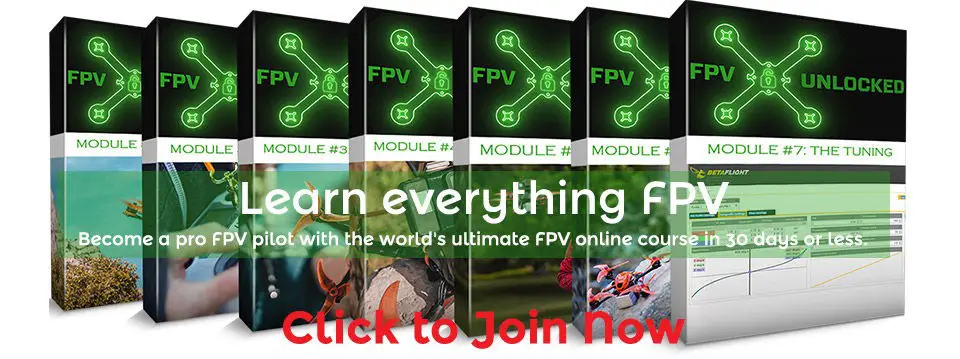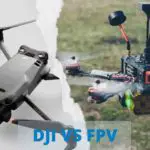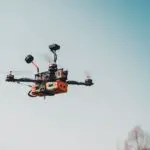If you want to start flying FPV drones, but don’t know where or what to start with, you are at the right place. I’ll lay out the best way to start your FPV journey.
To start flying FPV, get a radio transmitter and a realistic FPV simulator. Practice in simulation until you can fly comfortably. Then, order your first drone and goggles. In the meantime, study the legal requirements, safety rules, LiPo care guide etc, and prepare to take any tests required.
Having a clear direction on what you need to start flying FPV is not a must, but it would greatly reduce all the potential hassle that you may otherwise face. Let’s dive a little further into the rationale of the above suggestion. Do also check out my guide on the beginner mistakes that you should avoid.
Starting with FPV Simulator

Almost everyone who is in the FPV hobby practices with a simulator.
FPV simulators are software that mimics the physics of drones. It allows you to fly virtually without having the drone itself.
There are many FPV simulators out there. A good simulator has realistic physics, and allows you to practice using a real-life radio transmitter. These 2 are important features so that you can transfer what you’ve learned in the simulation to real life.
If you are not sure which FPV simulator to choose, check out my best FPV simulators for 2022.
Starting with an FPV simulator first allows you to get a feel on whether FPV is the right choice for you before you invest in an FPV drone and goggles. Some people may experience motion sickness with FPV, while some may realize that FPV is not as interesting as they thought. In those cases, they will be glad that they have not bought the expensive drone and goggles.
Even if you are sure that FPV is something you will be indulging in, practicing in simulators lets you learn to control the drone without worrying about crashing. Since you are new, you’ll crash frequently, and break your drone. Flying your drone after learning in a simulator will reduce the risk of damaging your drone from crashes.

Buy Your Drone Later
While you are practicing with a simulator, you can start shopping for an FPV drone and FPV goggles.
There are different types of FPV drones out there. In short, there are freestyle, racing, long range, and cinematic drones. Those drones are further divided by analog and digital FPV, and sizes. Choose the one that fits your needs.
Do check out my guide if you need help choosing your first FPV drone. I’ve also listed the best FPV goggles and criteria that you should consider when buying one.
FPV drones aren’t cheap. So, don’t make a rushed decision.
Read Legal Requirement and Safety
No matter how much you hate it, legal and safety are things that you cannot avoid. If you love this hobby, fly legally and safely to protect the image of this hobby.
In the US, flying drones are governed by the FAA or Federal Aviation Administration. You need to register either under The Recreational UAS Safety Test (TRUST) or Part 107 to legally fly your drone in public airspace. You can use this tool to check which one you should register yourself with.
On top of that, you will need to get a ham radio technician license in order to fly an FPV drone that uses non-FCC registered (Federal Communication Commission) video transmitter (VTX). Most VTX are not FCC-registered, so getting a ham radio is a must.
In some countries, you don’t need a ham radio license if the VTX transmission power is only 25 mW.
I have a guide on flying FPV legally and safety that you can refer to.
Understand How Drone Works
Unless you are flying DJI FPV (read my review here), FPV is all about DIY: from repairing to upgrading. Without knowing how an FPV drone works, you can’t even fix your crashed drone properly.
An FPV drone has multiple components such as a flight controller, ESCs, motors, propellers, VTX, radio receiver etc. mounted on the frame. Each component has different specifications and features that may vary between products.
Understanding each feature and specifications allow you to operate your drone properly, and make informed decisions when you want to upgrade your drone, or replace broken components.
Although it may sound overwhelming, it’s not that hard. Take a few minutes a day to read about those components, and I am sure you can pick them up.
Learn LiPo Care

LiPo battery packs are the commonly used batteries for FPV drones. They are dangerous if not handled with care.
Make sure you understand how to properly take care of LiPo batteries if you don’t want to burn your house down.
Besides that, LiPo packs are expensive, unlike alkaline batteries. You want to get the most out of it by maximizing its lifespan through best practices.
You can read my guide on LiPo care here.
On top of safe-handling and best practices, you also need to learn about in-flight battery management. Your drone does run out of battery in simulation, but it does in real life. Knowing when to land helps you in getting a longer battery life and protects your drone from unexpected crashes.


